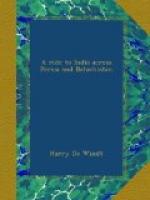The plain of Dasht-bi-Dowlat, or “The Unpropitious Plain,” lies between Mastung and Quetta. The name, however, only applies after the harvest has been gathered, for next to Mastung this is one of the most fertile spots in Baluchistan. Dasht-bi-Dowlat is mainly cultivated by wandering tribes. The inhabitants of Mastung were enthusiastic in their description of the plain in summer. Then, they told us, the surface is covered with verdure and flowers of all kinds, especially the “lala,” or tulip, which they averred cover it for miles with a carpet of crimson and gold, and load the air with sweet intoxicating perfume. The cultivation of this plain is mostly dependent on rain and heavy dews.
To the west of Dasht-bi-Dowlat is Chehel-Tan, a steep, rocky mountain, 13,000 feet high, in the ravines and valleys of which snow still lay deeply. Only two Europeans, Masson the traveller, and Sir Henry Green, have ever succeeded in reaching the summit, on which is a “Zariat,” or shrine. The ascent is difficult and dangerous, as, the mountain being said to be haunted, no native guides are procurable. The word “Chehel-Tan” signifies in Baluch “Forty Bodies,” and is derived from the following legend.
A frugal pair, many years married, were unblest with offspring. They therefore sought the advice of a holy man, who rebuked the wife, saying that he had not the power to grant her what Heaven had denied. The priest’s son, however (also a moullah), felt convinced he could satisfy her wishes, and cast forty pebbles into her lap, at the same time praying that she might bear children. In process of time she was delivered of forty babes—rather more than she wished or knew how to provide for. The poor husband, at his wits’ end, ascended to the summit of Chehel-Tan with thirty-nine, and left them there, trusting to the mercy of the Deity to provide for them, while the fortieth babe was brought up under the paternal roof.
One day, however, touched by remorse, the wife, unknown to her husband, explored the mountain with the object of collecting the bones of her children and burying them. To her surprise, they were all living and gambolling among the trees and rocks. Wild with joy, she ran back to her dwelling, brought out the fortieth babe, and, placing it on the summit of the mountain, left it there for a night to allure back its brothers, but, on returning in the morning, she found that the latter had carried it off, and it was never seen again. It is by the spirits of these forty babes that Chehel-Tan is said to be haunted.
At 8 a.m. on the 14th of April we sighted, afar off, an oasis on the dead green plain, of long barrack-like buildings, garden-girt bungalows, and white tents. We had reached our journey’s end. The church-bells were ringing as I rode into Quetta, for it was Sunday, and, unfortunately, a bright, fine morning. Had it been otherwise, I might have been spared the ordeal of riding, on a very dirty and attenuated camel, past




